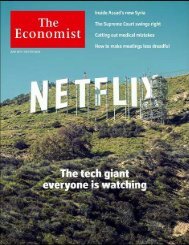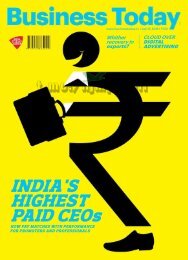Fortune
Create successful ePaper yourself
Turn your PDF publications into a flip-book with our unique Google optimized e-Paper software.
FOCUS<br />
INVEST<br />
or the 2011 toppling of Muammar Qaddafi<br />
in Libya—stock markets typically recover<br />
within five days. Still, geopolitics become a<br />
financial threat when they create stressful<br />
long-term conditions that hurt companies’<br />
profits and discourage investment. That’s why,<br />
of all the items on the global-strife laundry<br />
list, analysts worry most about trade wars.<br />
Most economists agree that restrictive tarifs<br />
hurt growth—and could do more damage<br />
today, when more companies rely on global<br />
sales and supply chains to sustain profits. The<br />
restrictions often backfire on the industries<br />
they’re designed to protect: In the 1980s, for<br />
example, the U.S. placed tarifs on steel from<br />
Japan, but 10 of the 11 largest U.S. steel producers<br />
saw negative equity returns from 1982<br />
to 1986, according to the Brookings Institution.<br />
The current environment has an added<br />
wrinkle, notes Tina Fordham, chief global<br />
political analyst at Citi: Countries have considered<br />
microtargeting sanctions at specific companies<br />
or subsectors. It isn’t hard to envision,<br />
for example, China retaliating against Trump<br />
administration tarifs by punishing Boeing,<br />
which got 13% of its sales from China last year.<br />
SHRUGGINGOFFSCARYNEWS?<br />
A recent study by Federal Reserve economists suggests that<br />
geopolitical conflict seldom correlates with prolonged slumps<br />
in stock prices. Trade wars, however, are uncharted territory.<br />
600%<br />
400<br />
200<br />
0<br />
MONTHLY CHANGE IN “GPR” INDEX<br />
(Occurrence of words related to geopolitical<br />
tensions in major international newspapers)<br />
S&P 500<br />
2000 2005 2010 MAY 2018<br />
SOURCES: CALDARA AND IACOVIELLO, MEASURING GEOPOLITICAL RISK; S&P GLOBAL<br />
WHAT’S THE BEST WAY TO ADJUST to such uncertainty? Historically, the<br />
industries that have held up best amid geopolitical risk in general<br />
and trade tensions in particular are defense, oil, and consumer<br />
staples. Defense stocks look pricey these days, however. Over the<br />
past five years, they have risen 20% annually, compared with 11%<br />
for the S&P 500, as investors sought to cash in on a growing Pentagon<br />
budget. “All the good news is priced in,” says Chris Higgins<br />
of Morningstar.<br />
The oil patch looks more promising. Times of turmoil tend to<br />
boost crude prices, to the benefit of big U.S. producers—of which<br />
the best positioned right now is Chevron (CVX, $123). The company<br />
endured criticism for recent investments in new production,<br />
particularly in Australia, but many of those wells are coming<br />
online just in time to capitalize on rising prices. Then there’s<br />
Texas’s Permian Basin, whose stunning energy boom Jefrey Ball<br />
depicted in our<strong>Fortune</strong> 500 issue (June 1). Chevron’s production<br />
there has risen from less than 150,000 barrels a day in early 2017<br />
to about 250,000 today, en route to a planned 650,000 by 2022.<br />
Those capabilities, along with an enviable balance sheet—Chevron<br />
generated $20.5 billion in cash flow from operations in 2017—<br />
make the stock about 25% undervalued today, assuming an oil<br />
price of $65 a barrel, says Jeferies analyst Jason Gammel.<br />
Kinder Morgan (KMI, $17), a huge operator of pipelines and<br />
terminals, doesn’t benefit immediately from rising oil prices. But<br />
as the surge encourages producers to dig more wells and invest in<br />
new projects, they’ll sign more of the transportation contracts that<br />
account for most of Kinder’s revenue. The<br />
company’s $37 billion debt load, a by-product<br />
of an infrastructure building spree, has scared<br />
some investors away: It trades at a 35%<br />
discount to peers in pipeline and “midstream”<br />
energy based on estimated 2019 distributable<br />
cash flow, says Raymond James’s Darren<br />
Horowitz. But its stable income and dominant<br />
position in energy infrastructure make it an<br />
attractive long-term play.<br />
No amount of global angst will make you<br />
stop purchasing food or toilet paper, and<br />
analysts expect consumer-staples stocks to<br />
benefit if trade tensions hurt other industries.<br />
Investors haven’t been impressed so far by<br />
aggressive cost cutting at Kraft Heinz (KHC,<br />
$58); shares in the packaged-foods giant have<br />
fallen more than 35% since rival Unilever<br />
rejected its takeover bid in February 2017.<br />
But the company now boasts the best profit<br />
www.t.me/velarch_official<br />
margins among its food peers, says Edward<br />
Jones analyst Brittany Weissman. If Kraft<br />
Heinz can start growing revenue again, “the<br />
stock will be rewarded for that,” Weissman<br />
says. And even if not, its healthy margins<br />
could make it look like a haven when<br />
investors scurry for safety.<br />
42<br />
FORTUNE.COM<br />
// JULY.1.18<br />
GRAPHIC BY NICOLAS RAPP
















